|
|
| |
|
 | Search: |
|
|
|
|
|
 |

|
|
WiFi BLE click is a Click board™ which provides WiFi and BT/BLE connectivity for any embedded application. It features the ESP32-WROOM-32, an integrated wireless connectivity solution. The ESP32-WROOM-32 module itself is based on the ESP32-D0WDQ6 chip, a powerful 32-bit SOIC that runs RTOS featuring LwIP and TLS 1.2 with hardware acceleration. Armed with such a powerful processor, the ESP32-WROOM-32 can achieve data rates of up to 150 Mbps. The ESP32-WROOM-32 can achieve up to 20 dBm of TX power, ensuring a reliable connection and good signal coverage. It offers an UART communication interface allowing it to be operated by using simple AT commands.
WiFi BLE click is supported by a mikroSDK compliant library, which includes functions that simplify software development. This Click board™ comes as a fully tested product, ready to be used on a system equipped with the mikroBUS™ socket.
|
|
|
|
|
 |

|
|
WiFi ESP click carries the ESP-WROOM-02 module that integrates ESP8266EX. The click is designed to run on a 3.3V power supply. It communicates with the target microcontroller over UART interface and the following pins on the mikroBUS™ line: RST, CS. |
|
|
|
 |

|
|
WiFi PLUS Click is an accessory board in the mikroBUS form factor. It is a compact solution for adding WiFi communication to your device. It features the MRF24WB0MA - 2.4GHz, IEEE std. 802.11 - compliant module as well as the MCW1001 companion controller with on-board TCP/IP stack and 802.11 connection manager. WiFi PLUS click communicates with target boards via a UART interface. It is designed to use a 3.3V power supply only. It also features an option to achieve low power consumption. |
|
|
|
 |
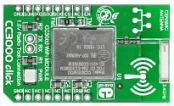
|
|
CC3000 click is an add-on board in the mikroBUS form factor. It features the CC3000MOD WiFi module, as well as a ceramic antenna, for adding WiFi functionality without requiring too much Wi-Fi or RF expertise. The Texas Instruments CC3000MOD integrates the IPv4 TCP/IP stack with built-in network protocols (ARP, ICMP, DHCP client and DNS client). This simplifies connection to local networks and/or the Internet, while minimizing software requirements for the target board MCU. The CC3000 click enables OFDM rates from 1 to 54 Mbps in the 2.4-GHz ISM band. CC3000 also has integrated EEPROM memory. The ceramic antenna has a maximum range of about 70 meters in open space. The board is designed to operate on a 3.3V supply only, and communicates via a SPI interface. |
|
|
|
 |

|
|
If you are building an IoT device that connects to the internet through WiFi, your two biggest concerns are power consumption and security – both major strengths of the module onboard CC3100 click.
This WiFi click board carries the successor of the highly popular CC3000 module from Texas Instruments. Its claim to fame was that it simplified WiFi for embedded developers by integrating multiple Internet Protocols and a Wifi driver with a simple API.
CC3100 inherits all these benefits, and on top of that, adds an updated protocol stack (support for 802.11n) and cutting edge security features (TSL encryption, hardware crypto-engine and more). |
|
|
|
 |
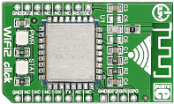
|
|
WiFi2 click is an affordable solution for adding WiFi functionality to your design, especially suited for IoT applications. The board carries the HLK-M30 WiFi module that’s easy to configure (you can set it up with either a static or dynamic IP address), and it can work both as a TCP/IP client or server. In addition, it supports multiple authentication mechanisms and network protocols. The board communicates with the target board microcontroller through UART (TX, RX), RST and ANT lines. It's designed to use a 3.3V power supply. |
|
|
|
 |
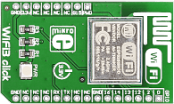
|
|
WiFi3 is a complete self-contained WiFi solution carrying the ESP8266 module with a system on chip. The module has an integrated TCP/IP stack, supports Wi-Fi Direct (p2p) and boasts powerful processing and storage capabilities that offload all networking functions from the MCU. Alongside a standard mikroBUS socket, with WiFi3 click you’ll also have additional 6 GPIO pins at your disposal. WiFi3 communicates with the target board microcontroller through mikroBUS RX, TX, AN (PWD) and RST (G15) lines. The board uses a 3.3V power supply only. |
|
|
|
 |

|
|
WiFi 4 click carries SPWF01SA, a complete standalone WiFi module with a single-chip 802.11 b/g/n transceiver, a 32-bit STM32 MCU, along with a built-in 2.4 GHz ISM band antenna. The onboard module has 1.5 MB of internal flash and 64 KB of RAM, plus a fully integrated TCP/IP protocol stack with added web server and application service capabilities. WiFi4 click communicates with the target MCU through the mikroBUS UART interface, but the board also features additional 14 GPIO pins. Uses a 3.3V power supply only. |
|
|
|
 |

|
|
WiFly click carries RN-131, a standalone, embedded wireless LAN module. It allows you to connect your devices to 802.11 b/g wireless networks. Preloaded firmware simplifies integration. The mikroBUS UART interface alone (RX, TX pins) is sufficient to establish a wireless data connection (with speeds up to 1 Mbps); the module is controlled with simple ASCII commands (for scanning, authenticating and connecting to Wi-Fi networks). A multitude of networking applications are built in: DHCP, UDP, DNS, ARP, ICMP, TCP, HTTP client, and FTP client. Additional functionality is provided by RST, WAKE, RTSb and CTSb pins. 3.3V power supply only. |
|
|
|
 |

|
|
WiFi 6 click is a mikroBUS™ add-on board with Bluegiga's WF121-A self-contained Wi-Fi module. With a fully integrated radio and 32-bit microcontroller, this module is ideal for embedded applications.
The module's 2.4GHz band radio is fully compliant with IEEE 802.11b/g/n and offers excellent radio performance. Allows end user applications to be embedded onto the integrated PIC32MX695H, a 32-bit 80MHz microcontroller with 128KB RAM and 512KB Flash memory, for development of lower-cost and smaller sized products. Also integrated on-board is a single power supply.
WiFi 6 click communicates with the target MCU through the mikroBUS™ UART (TX, RX), SPI, or IC2, with additional functionality provided by CTS pin (in place of default mikroBUS™ INT pin); a mikroProg connector allows to update the firmware of the internal PIC32. SPI interface can be accessed by jumpers on the click board. The board is designed to use a 3.3 power supply only. |
|
|
|
 |
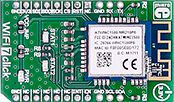
|
|
WiFi 7 click carries the ATWINC1510-MR210PB IEEE 802.11 b/g/n module, specifically optimized for low-power IoT applications. The click is designed to run on a 3.3V power supply. It communicates with the target microcontroller over SPI interface, with additional functionality provided by the following pins on the mikroBUS™ line: PWM, INT, RST. |
|
|
|
 |
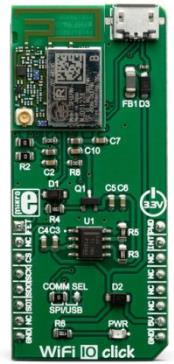
|
|
WiFi 10 click is a Click board™ that offers an ultra-low power wireless connectivity, for any IoT application. It is based on the SX-ULPAN-SB-2401, an integrated wireless LAN module, compliant with the IEEE802.11a/b/g/n wireless networking protocols, at 2.4GHz. The ULPAN-SB-2401 module comes equipped with a PCB trace antenna, but it also offers a small Hirose U. FL connector allowing an external antenna to be used for improved range. The ULPAN-SB-2401 module supports IPv4, TCP, and UDP transfer protocols. It also provides support for WPS, WPA, and WPA2 security protocols, allowing a secure connection.
WiFi 10 click is supported by a mikroSDK compliant library, which includes functions that simplify software development. This Click board™ comes as a fully tested product, ready to be used on a system equipped with the mikroBUS™ socket.
|
|
|
|
 |

|
|
WiFi NINA click is a powerful standalone WiFi module, equipped with the state-of-the-art NINA-W132 module from u-blox, that can be easily configured with the u-blox s-center software, using AT commands. WiFi NINA click offers a complete WiFi stack, it is really easy to use and provides a simple way to build secure IoT applications.
This WiFi module integrates a powerful dual 32bit MCU and a radio for wireless communication. It comes with preprogrammed application software that supports 802.11b/g/n in the 2.4 GHz ISM band. WiFi NINA click also features an RGB diode, which is used to display the connection status of the device. These features make this click a perfect and secure IoT solution. It can also be used for any type of WiFi networks, medical and industrial networking, home/building automation and other applications that require wireless network access. |
|
|
|
 |
|
|

